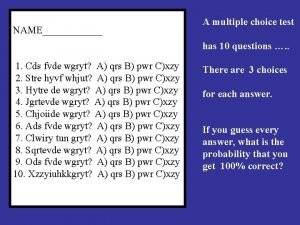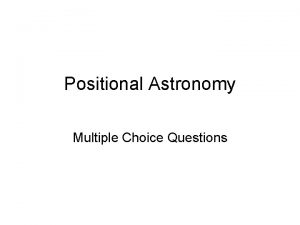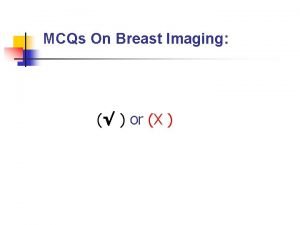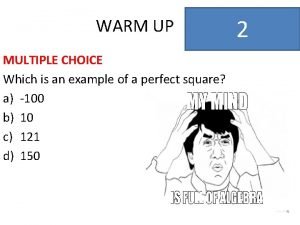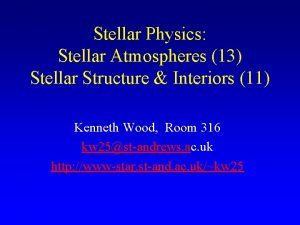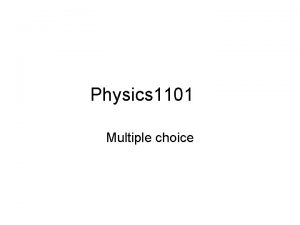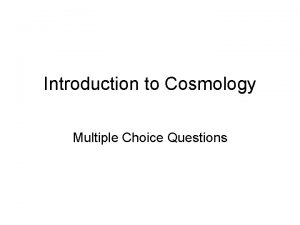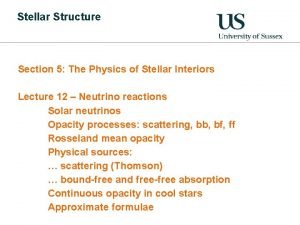Stellar Physics 2 Multiple Choice Questions Test Question




























- Slides: 28

Stellar Physics 2 Multiple Choice Questions

Test Question Does this quiz work? A. Yes B. No

Stellar Physics 2 1. Which of the following statements are FALSE? A. Low mass stars (<8 Msun) fuse up to carbon. y B. High mass stars (≥ 8 Msun) fuse up to iron and nickel. C. Low mass stars (~1 Msun) fuse up to carbon. D. High mass stars (>1 Msun) fuse up to iron and nickel.

Stellar Physics 2 2. Which of the following is an incorrect statement about supernovae? A. Supernovae brighten rapidly to ~109 Lsun in about 10 days, then slowly dim over about 100 days. B. A supernovae can temporarily outshine its host galaxy. C. The energy source of a supernovae is the release of gravitational potential energy by the contraction of the core. D. Stars of the Sun’s mass and above will turn into black holes. y

Stellar Physics 2 3. The Heisenberg uncertainty principle relates what two variables? A. Uncertainty in mass and uncertainty in momentum. B. Uncertainty in mass and uncertainty in position. C. Uncertainty in momentum and uncertainty in position. y D. Uncertainty in momentum and uncertainty in time.

Stellar Physics 2 4. The central pressure required to a body against its own self gravity is given by Pc = ___πGρ2(R 2/2). What is the scalar value that needs to be inserted in the blank to complete the expression? A. 4/3. y B. 5/3. C. 7/3. D. 1/3.

Stellar Physics 2 5. What is the Chandrasekhar Mass Limit? A. The minimum mass that a white dwarf can be. B. The minimum mass that a neutron star can be. C. The maximum mass that a white dwarf can be. Y D. The maximum mass that a white dwarf can be.

Stellar Physics 2 6. What is the pressure source in a white dwarf? A. Electron degeneracy pressure. y B. Neutron degeneracy pressure. C. Proton degeneracy pressure. D. Gravitational potential energy.

Stellar Physics 2 7. In a white dwarf, how does degeneracy pressure vary with density? A. Pressure varies with density as ρ4/3. B. Pressure varies with density as ρ5/3. y C. Pressure varies with density as ρ7/3. D. Pressure varies with density as 1/ρ.

Stellar Physics 2 8. Which of the following statements about white dwarfs is FALSE? A. They are supported by electron degeneracy pressure. B. They are very small but very bright. Y C. They have much leftover gravitational energy from collapse so they are very hot. D. They have a very high density: ~109 kg m-3.

Stellar Physics 2 9. How big would a neutron star of a few solar masses be expected to be? A. Radius 1 km. B. Radius 10 km. Y C. Radius 100 km. D. Radius 1000 km.

Stellar Physics 2 10. Which of the following statements about neutron stars is true? A. Neutron stars are stars with a mass above the Chandrasekhar Mass limit and its electrons have become relativistic. Y B. Neutron stars are stars with a mass below the Chandrasekhar Mass limit and its electrons have become relativistic. C. Neutron stars are stars with a mass above the Chandrasekhar Mass limit, its electrons are yet to become relativistic. D. Neutron stars are stars with a mass below the Chandrasekhar Mass limit, its electrons are yet to become relativistic.

Stellar Physics 2 11. What is the Oppenheimer-Volkoff Mass Limit? A. The critical mass above which neutron degeneracy pressure is unable to support the white dwarf in a stable equilibrium. B. The critical mass below which neutron degeneracy pressure is unable to support the neutron star in a stable equilibrium. C. The critical mass below which neutron degeneracy pressure is unable to support the white dwarf in a stable equilibrium. D. The critical mass above which neutron degeneracy pressure is unable to support the neutron star in a stable equilibrium. y

Stellar Physics 2 12. In a neutron star, how does degeneracy pressure vary with density? A. Pressure varies with density as ρ4/3. B. Pressure varies with density as ρ5/3. y C. Pressure varies with density as ρ7/3. D. Pressure varies with density as 1/ρ.

Stellar Physics 2 1. 13. How does the radius of a neutron star depend on its mass? A. It doesn't - all neutron stars have the same finite radius. B. It doesn't - all neutron stars have zero radius (i. e. are point-like). C. More massive neutron stars are larger. y D. More massive neutron stars are smaller.

Stellar Physics 2 14. Which of the following statements about neutron stars is FALSE? A. They are mostly made up of neutron degenerate matter, with an outer ‘crust’ of white-dwarf-like material. B. They have exhausted most of their gravitational potential energy so they are cool. y C. They are extremely small. D. They are supported by neutron degeneracy pressure.

Stellar Physics 2 15. The escape velocity is given by Ve = (2 GM/R)1/2. Schwarzschild replaced Ve with c and rearranged to find the radius named after him. What does this expression become? A. Rs = GM/c 2. B. Rs = 2 GM/c 2. y C. Rs = GM/c. D. Rs = 2 GM/c.

Stellar Physics 2 16. A planet could sit in a stable orbit close to a black hole (outside R s) without being sucked in, true or false? A. True. Y B. False.

Stellar Physics 2 17. Can energy escape a black hole? A. No. B. Yes. Y C. Yes, but who knows where, maybe in a parallel universe.

Stellar Physics 2 1. 18. What will happen to a 5 solar mass black hole in a dense nebula? A. The black hole will not interact with the nearby space at all, so its mass will remain constant. B. In-falling matter and radiation will exceed Hawking radiation, so the black hole will grow. C. Hawking radiation will exceed in-falling matter and radiation, so the black hole will evaporate. y D. None of the above.

Stellar Physics 2 19. _____ = 1066(M/Msun)3. What is this an expression for and what are its units? A. The rate of energy loss for a black hole through Hawking Radiation in J/s. B. The time for a black hole to completely evaporate through Hawking Radiation in years. y C. The time for a black hole to completely evaporate through Hawking Radiation in seconds. D. The rate of energy loss for a black hole through Hawking Radiation in J/year.

Stellar Physics 2 20. Which of the following is the correct form of the distance modulus formula? A. M – m = 5 log 10 d – 5. B. m – M = -2. 5 log 10 – 5. C. M – m = -2. 5 log 10 – 5. D. m – M = 5 log 10 – 5. y

Stellar Physics 2 21. Neutron stars do not have a very large angular momentum? A. True. B. False. y

Stellar Physics 2 22. In order to calculate the centrifugal break up limit, you need to know an equation for the centripetal acceleration, which of the following is such an equation? A. a = ω2 r. y B. a = ω2/r. C. a = ωr. D. a = ω/r.

Stellar Physics 2 23. The plasma making up a collapsing stellar core has a magnetic field, what will happen to the magnetic field lines as the star collapses? A. They will move closer together. B. They will remain unchanged. y C. They will move further apart. D. They will disappear.

Stellar Physics 2 24. What is a pulsar? A. It is a neutron star that does not lie in hydrostatic equilibrium and thus pulses in size and luminosity. B. It is a neutron star of which the magnetic field pulses in and out thus accelerating a stream of charged particles with each pulse. C. It is an asymmetric neutron star (due to an accretion disk), which, as it rotates shows its brighter and then darker side to earth thus giving the appearance of pulsation. D. It is a rapidly rotating neutron star with a strong magnetic field at the poles which accelerates charged particles into a beam at either pole. y

Stellar Physics 2 25. Which of the following statements about observational signatures of black holes are true? A. There is strong evidence of both gravitational microlensing and gravitational waves. B. There is promising signs of gravitational microlensing but none of gravitational waves yet. y C. There is promising signs of gravitational waves but none of gravitational microlensing yet. D. There is no evidence at all of either gravitational microlensing or gravitational waves.

Stellar Physics 2 26. In a degenerate gas of electrons and protons, why can the protons still be non- relativistic even when the electrons have become relativistic? A. Protons are positively charged, whereas electrons are negatively charged, so electrons become relativistic first. B. Protons are much more massive than electrons, and since both the protons and electrons have the same individual particle momentum the protons move much more slowly. y C. Protons individually have less momentum than electrons in a degenerate gas. D. They can't - all particles become degenerate at the same point.
 A multiple choice test has 10 questions
A multiple choice test has 10 questions Chapter 30 seeking employment milady
Chapter 30 seeking employment milady How to write multiple choice questions
How to write multiple choice questions Act iv merchant of venice
Act iv merchant of venice Monstrous joy in the story of an hour
Monstrous joy in the story of an hour What is stimulus in mcq
What is stimulus in mcq Adverb quiz multiple choice
Adverb quiz multiple choice Exercises for microsoft word
Exercises for microsoft word Multiple choice questions for primary students
Multiple choice questions for primary students Astronomy questions and answers multiple choice
Astronomy questions and answers multiple choice Persuasive writing mcqs with answers pdf
Persuasive writing mcqs with answers pdf The plot of oedipus deals mainly with
The plot of oedipus deals mainly with Poetry multiple choice sonnet
Poetry multiple choice sonnet In figure 10-4 what role does structure a play in mitosis
In figure 10-4 what role does structure a play in mitosis Mammography mcqs
Mammography mcqs Growth mindset multiple choice questions
Growth mindset multiple choice questions Biomes multiple choice questions with answers
Biomes multiple choice questions with answers Ap lang test structure
Ap lang test structure Alteryx certification
Alteryx certification Multiple choice questions on sustainable tourism
Multiple choice questions on sustainable tourism Which command is used to set terminal io characteristic?
Which command is used to set terminal io characteristic? Tone multiple choice questions
Tone multiple choice questions Multiple choice questions on photoelectric effect
Multiple choice questions on photoelectric effect Multiple choice questions on flowering plants
Multiple choice questions on flowering plants Vignette-style multiple choice
Vignette-style multiple choice Ap world history chapter 17 multiple choice questions
Ap world history chapter 17 multiple choice questions Multiple choice questions on conjunctions
Multiple choice questions on conjunctions Multiple choice questions on chicken pox
Multiple choice questions on chicken pox Quadratic equations mcq
Quadratic equations mcq
